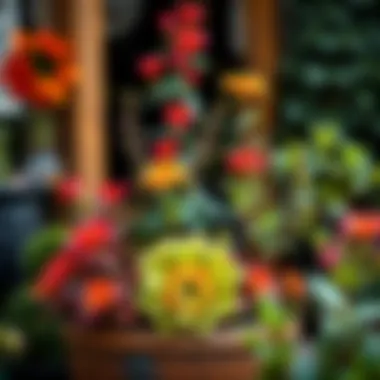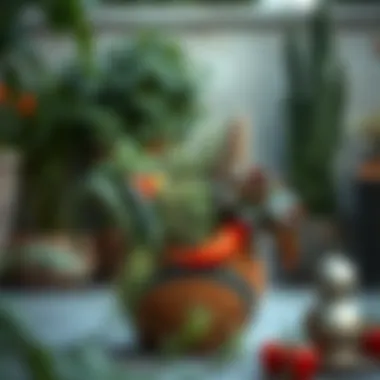Effective Planting Strategies for Large Outdoor Pots


Intro
As the world becomes more urbanized, the love for gardening has found a new canvas—large outdoor pots. These containers can transform even the tiniest balcony or patio into a green oasis, providing space for vibrant displays of flora. However, planting in large pots isn't simply a matter of tossing in some soil and a few plants; it requires a thoughtful approach to achieve the best results.
Understanding the strategies behind planting in larger containers opens a Pandora's box of creative and functional possibilities. It's about more than just aesthetics; these pots allow for a variety of blooming flowers and lush greenery that can breathe life into any outdoor space. Moreover, they offer homeowners, designers, and gardening aficionados a chance to experiment with different plant types, from hardy succulents to flourishing herbs and vegetables.
So, whether you’re an experienced green thumb or just starting out, prepare to explore various styles and methods that elevate your outdoor aesthetic. Let's dig in!
Understanding Container Gardening
Container gardening has become increasingly popular, especially for those who want to dabble in gardening without the challenges of a traditional garden bed. This style of gardening is particularly useful for those who may be limited in space, such as urban dwellers or homeowners with small yards. Large outdoor pots provide a dynamic solution to a myriad of gardening hurdles, from soil quality to sunlight accessibility.
Definition of Container Gardening
At its core, container gardening is the practice of growing plants in pots or containers rather than in traditional garden beds. This approach allows a gardener to control various growing conditions, such as soil quality, moisture, and fertility. Practically any type of plant can be grown in a container, from vibrant flowers to hearty vegetables.
Container gardening isn't just a trend—it's an established method that can yield beautiful results with the right techniques. The concept centers around versatility, enabling enthusiasts to tailor their growing environment and make the most of what they have in terms of space and design. It opens doors for creativity, allowing one to create a garden that can be moved and rearranged as desired.
Benefits of Using Large Outdoor Pots
Growing plants in large outdoor pots comes with a slew of benefits that can elevate any gardening experience. Here are some notable advantages:
- Mobility and Flexibility: Large pots can be shifted easily. If a particular spot doesn’t work out for a plant, simply relocate it. This can help maximize sunlight exposure or avoid problematic weather conditions.
- Soil Control: Gardeners can curate their own potting mixes, ensuring that the plants get the nutrients needed for their specific growth requirements. This tailored approach is especially beneficial for plants with unique needs.
- Reduced Weeding: A well-maintained container garden can lessen the likelihood of weeds taking root and stealing nutrients from your plants. With less space for weeds to establish, you can focus more on nurturing your desired foliage.
- Aesthetic Appeal: Larger pots present an opportunity to make striking visual displays. Whether arranging flowers or vegetables, these striking pots can enhance any landscape, providing vibrancy to patios, balconies, or yards.
- Easier Maintenance: Managing water needs can be simplified through containers, which can, in some cases, help regulate moisture levels due to better drainage than typical garden beds.
"Gardening in pots gives you the freedom to plant what you want, where you want. It's all about creating your little paradise with ease."
Choosing the Right Large Pots
Selecting the appropriate large pot for your outdoor plants is more than just a matter of aesthetics—it's foundational to your gardening success. Choosing the right large pots can significantly influence the health and growth of your plants. This means considering aspects like material, size, drainage, and how they fit into your overall garden design. The wrong choice can lead to stunted plants or those that are susceptible to pests and diseases.
Materials and Durability
The material of large pots plays a crucial role in durability and maintenance. Gardeners often find themselves faced with several material options. Here’s a rundown of the most common:
- Terracotta: These clay pots are porous, allowing air and moisture to pass through. They offer good drainage, but can crack in freezing temperatures. Ideal for situations where you want to ensure your plants breathe.
- Plastic: Lightweight and inexpensive, plastic pots can withstand various weather conditions. However, they might not provide adequate insulation for roots during extreme temperatures. They do come in a variety of colors and styles, making them versatile for design.
- Metal: Depending on the type, metal pots can be very durable. However, they can heat up quickly, risking root damage in hotter seasons. They often carry a modern aesthetic, but you must consider insulation.
- Cement/Concrete: Very sturdy and able to hold large amounts of soil, these materials can be quite heavy. They do retain heat but may require sealing to prevent water absorption. Their robust nature is great for permanent placements but less ideal if you like to move pots around.
Keep in mind that pot longevity is linked not only to material but also to craftsmanship. A well-made pot can last for many years despite the elements.
Size and Depth Considerations
Size matters. It's essential to choose a pot that complements the growth habits of your chosen plants. A pot too small can limit root growth, leading to weak plants. Here are a few important notions:
- Depth: Shallow pots might not be suitable for deep-rooted plants. Standard vegetables, like tomatoes or peppers, often require deeper containers, ideally at least 12 inches deep! On the other hand, herbs such as basil can thrive in shallower pots.
- Width: Wider pots allow for more soil and thus, moisture retention, which is crucial for plants with more expansive root systems. Consider the full-grown size of the plant before making your choice. For larger plants, you could think about a pot that is at least twice the diameter of its root ball.
- Growth Time Frame: Consider how long you expect to keep plants in those pots. If you're transitioning annuals, a smaller pot might suffice. Perennials or shrubs might require not only larger pots, but those that accommodate growth over several seasons.
Choosing the right large pots is not just about practicality; it’s an art. The right choice enhances not only the health of your plants but the overall beauty of your garden. Think of your pots as an extension of your home, blending utility and style, showcasing your green thumb while providing an optimum environment for growth.
"Plants in the right pot not only flourish but radiate their natural beauty!"
By being thoughtful in your selections regarding materials and sizes, you set the stage for a flourishing garden, full of life and color. For additional resources, you can check out articles on Wikipedia for further insights or visit Britannica for more about container gardening history and techniques.
Plants for Aesthetic Appeal
Creating visually appealing outdoor spaces is often about combining elements that ignite the senses and capture attention. When it comes to large outdoor pots, the selection of plants plays an instrumental role in achieving the desired aesthetic. A well-thought-out arrangement does not only transform a space but also enhances the character of your garden or patio.
Choosing the right plants for aesthetic appeal involves focusing on color, texture, and form. The juxtaposition of various heights and shapes can add depth to your arrangement. When done rightly, vibrant blooms and rich foliage can elevate an ordinary pot into a stunning centerpiece.
Flowering Plants for Color
Flowering plants are often the heartbeat of any display. The hues of the blossoms can significantly impact the overall look of your garden. Consider the following when choosing flowering plants:
- Seasonal Blooms: Picking plants like pansies or snapdragons that flourish in spring can set a colorful tone as the weather warms up. Chrysanthemums or pansies can bring warmth to your autumn backdrop.
- Color Schemes: Think about complementary colors. Mixing yellows, purples, and whites can create a pleasing palette. However, bold combinations, like vibrant reds alongside deep blues, can also make a striking statement.
- Height Variation: Use taller flower varieties like delphiniums or sunflowers at the back or middle of your pot arrangements, while shorter blooms like calibrachoa can cascade over the edges. This layering not only adds visual interest but creates a 3-dimensional feel.
"The beauty of flowers is not merely in their color; it lies in how they embrace and elevate the spaces around them."
Foliage Plants for Texture
Green leaves might seem plain, but they don’t just serve as a backdrop; they provide texture and depth. Incorporating a mix of foliage plants alongside flowering ones enriches your design significantly. Here are some points to consider:
- Diverse Foliage: Hostas and ferns can furnish a soft, lush look with their broad, feathery leaves. The varying shapes and patterns found in foliage can contrast beautifully against the delicacy of flowers.
- Color Variations: Not all foliage is plain green. Consider plants like coleus, with their vibrant leaves, or purple heart, bringing a darker tone that can add drama to your pot arrangement.
- Maintenance Needs: Remember to select foliage plants that match your flowering plants in terms of water and light requirements. For instance, if you’ve chosen sun-loving flowers, opt for sun-tolerant foliage varieties.
There’s artistry in planting. By thoughtfully selecting flowering and foliage plants, one can compose an arrangement that captivates and enchants at every glance. For guidance on the ideal plants to pair, consider browsing resources like Wikipedia or specialized gardening sites like Britannica.
With a little creativity and an eye for beauty, you can transform your outdoor pots into spectacular floral canvases that the world won’t forget.
Herbs and Vegetables in Pots
Growing herbs and vegetables in pots provides a unique opportunity for garden enthusiasts, homeowners, and even beginner DIYers to engage in sustainable gardening, right from their balconies, patios, or small backyards. Container gardening allows individuals to cultivate a diverse selection of edible plants without the need for expansive soil space. With thoughtful selection, you’ll be able to enjoy fresh produce at your fingertips, enhancing your culinary delights and optimizing your outdoor space.
Starting a Culinary Garden
Embarking on a culinary garden in pots starts by understanding the vibrant world of flavors and scents that herbs and vegetables can introduce to your cooking. Instead of just heading to the grocery store for a sprig of basil or a handful of cherry tomatoes, imagine stepping outside your door, scissors in hand, ready to snip fresh ingredients. This experience is not just delightful; it nurtures a greater connection with what you consume.
To initiate this journey, consider the following steps:
- Assess Space: Evaluate how much room you can allocate for your pots, taking into account sunlight exposure and accessibility for harvesting.
- Select Herbs: Begin with easy-to-grow herbs like basil, mint, and chives. These provide robust flavors and can flourish in various pot sizes.
- Plan for Vegetables: If you’re inclined to grow vegetables, start with varieties that adapt well to container life such as radishes, lettuce, or even dwarf tomato plants.
Remember, the joy of gardening comes with trial and error. Don’t fret over minor setbacks—adjustment is part of the learning experience!


Ideal Vegetables for Container Growth
When it comes to selecting vegetables for your pots, some varieties thrive better than others. The key is to pick those that are not only hearty but also suited for confined spaces. Here’s a brief rundown:
- Leafy Greens: Spinach and lettuce are fantastic choices. They grow quickly and will keep producing leaves if harvested correctly.
- Root Vegetables: Carrots and radishes are well-suited for pots, allowing them to develop without competing for space underground. Just make sure your pot is deep enough!
- Compact Varieties: Look for dwarf varieties of plants like peppers and tomatoes. These are bred specifically for container growth while still yielding delicious produce.
“Gardening is not about instant gratification but about nurturing growth and celebrating the process.”
In addition to considerations of variety, it’s crucial to ensure adequate drainage and proper soil to maximize the potential of your culinary garden. Well-draining potting mix complemented by proper sunlight and diligent watering will pave the way for robust plant health. Remember, a successful herb and vegetable garden in pots can lead not only to culinary joy but also to a flourishing lifestyle and wellness.
Companion Planting Strategies
Companion planting is a powerful technique that plays a crucial role in maximizing the potential of large outdoor pots. By pairing compatible plants together, gardeners can create a more productive and healthier garden ecosystem, which benefits everyone from homeowners to professional landscapers. This strategy takes advantage of the natural relationships that exist between different plant species, allowing them to enhance each other's growth, reduce pest problems, and even improve flavors in culinary herbs and vegetables.
Enhancing Growth through Companions
When selecting plants for your outdoor pots, the principle of companion planting suggests that some plants can nurture and support each other's growth, while others may hinder it. Choosing the right companions helps in several ways:
- Nutrient Sharing: Certain plants can enrich the soil with nutrients that their companions need. For instance, legumes like peas or beans fix nitrogen in the soil, which can then be utilized by neighboring plants.
- Space Utilization: Different plants grow at varied rates and sizes. For example, tall sunflowers can provide shade to shorter basil plants, which might otherwise suffer from too much sun exposure.
- Pest Control: Some plants possess natural pest-repelling qualities. Marigolds are often planted near tomatoes to deter nematodes and other pests. Combining these types can reduce your reliance on chemical pesticides.
By considering these factors, gardeners can cultivate a thriving environment even within the limited space of outdoor pots.
Examples of Effective Combinations
Several plant combinations have proven effective through experience and study. Here are a few notable pairings that can elevate both the aesthetics and functionality of your patio or garden:
- Tomato and Basil: This pairing is not only culinary magic but also practical. Basil can repel pests like aphids and spider mites that typically trouble tomatoes.
- Carrots and Onions: These two can coexist harmoniously. Onions help mask the scent of carrots, confusing carrot flies, while carrots aerate the soil, benefiting their companion.
- Lettuce and Radishes: Rapid-growing radishes can act as a trap crop, drawing pests away from slower-growing lettuce, allowing it to flourish.
"Companionship in the plant world can mean life or death for crops, and knowing the right pairings makes all the difference."
By implementing these partnerships, you not only increase the yield of your pots but also create a visually appealing and diverse garden layout.
Selecting the Soil
Selecting the right soil is a vital step in ensuring that plants thrive in large outdoor pots. The significance isn't simply about filling the pot with dirt; it’s about understanding the needs of the plants and providing them with a nurturing environment. Quality potting mix can elevate your gardening game and bolster plant health, growth, and productivity.
Importance of Quality Potting Mix
Potting mixes are specifically formulated to provide adequate drainage, aeration, and nutrition for container plants. Unlike regular soil, which can become compacted, a good quality potting mix is designed to maintain a light consistency. This is essential for healthy root development. When the roots have room to breathe, the plants absorb nutrients more effectively, leading to vibrant foliage and blooming.
A quality potting mix often contains various components, such as peat moss or coconut coir, which retain moisture while allowing excess water to drain. These ingredients also provide the necessary structure to avoid soil erosion. Importantly, a suitable mix can minimize the risk of disease. Potted plants are particularly susceptible to root rot if they sit in waterlogged conditions, so the right mix reduces this risk significantly.
Furthermore, some potting mixes contain slow-release fertilizers that supply essential nutrients over time. This can help to eliminate the guesswork associated with feeding schedules for container plants, allowing you to focus on other aspects of gardening.
Incorporating Organic Matter
Incorporating organic matter into your potting soil is a sure-fire way to enhance the health of your outdoor pots. Organic matter, such as compost, worm castings, or well-rotted manure, serves multiple purposes.
Benefits of Organic Matter:
- Nutrient Supply: Organic materials break down gradually, providing a steady stream of nutrients over the growing season. This is great for plants since they don't experience spikes in nutrient levels that can lead to stress.
- Moisture Retention: Organic matter has a remarkable capacity to hold water. This property can be particularly beneficial during dry spells, ensuring that your potted plants have consistent moisture at their roots.
- Soil Structure Improvement: Adding organic matter helps improve the overall structure of the potting mix, providing better aeration and drainage. This promotes healthy root growth and reduces the chances of overwatering.
- Microbial Activity: A healthy dose of organic matter encourages the growth of beneficial microbes. These organisms contribute to breaking down nutrients into forms that plants can easily absorb, enhancing soil fertility.
To incorporate organic matter, mix it into your potting soil at a ratio of about 1:3, organic matter to potting mix. Doing this not only enriches the mix but also leads to more robust plants that can withstand environmental pressures better.
"Quality potting mix plus organic matter equals happy plants!"
In summary, selecting the right soil and enhancing it with organic matter sets the stage for successful container gardening. This foundation affects everything from plant health to overall aesthetic appeal and ease of maintenance. Investing the time and effort into selecting quality soil will undoubtedly pay dividends in the long run.
Lighting Considerations
Proper lighting is key to the success of any container garden. In large outdoor pots, the relationship between the plants and sunlight can directly influence growth rates, flowering, and overall health. Plants thrive under conditions that suit their specific lighting needs, meaning that understanding these requirements is imperative if you want to cultivate a flourishing outdoor space. Choosing the right locations for your pots can optimize these factors, ultimately leading to a more vibrant garden.
Assessing Sunlight Requirements
Each plant has its own preferences regarding sunlight. Some species prefer full sun, while others thrive in partial shade. To get started, consider the following:
- Full Sun: Plants that need six or more hours of direct sunlight every day fall into this category. Examples include tomatoes and most flowering plants.
- Partial Shade: Plants like ferns and certain herbs might prefer 3-6 hours of sunlight. They can thrive in glimmering morning sun but may struggle in harsh afternoon rays.
- Full Shade: A few plants will do best without direct sunlight, relying on indirect light to survive. Consider robust varieties like certain hostas or bee balms.
It's essential to assess the sun patterns in your yard or patio. Watch how shadows shift throughout the day, and note which areas get the most sunlight during different seasons. Keeping a little notebook might be beneficial; jot down observations and remember which times the sun is on the pots best. Small commitments like this can help ensure the right plants go in the right pots!
Adjusting for Seasonal Changes
As seasons change, so do the sunlight conditions. This can impact your garden, especially if you're using large outdoor pots that need rotates or some form of adjustment. For instance:
- Spring Transition: As days gradually get longer, you might find that sun exposure in the early spring isn’t same as later. Ensure that your pots are positioned to maximize this new exposure!
- Summer Brightness: Long days are an opportunity, but extreme heat can become a problem. During the hottest months, a little strategic shading can help keep pots cooler. A light fabric cover can shield pots during peak hours without cutting off too much light.
- Autumn Adjustments: As the daylight hours start to dwindle, check to see if sunlight is waning on certain pots, especially those that once basked in summer light. This may be a good time to rearrange pots or rotate plants that thrive in reduced light.
"Positioning your pots with seasonal changes in mind can greatly improve plant vitality."
Watering Techniques
Proper watering is the backbone of successful container gardening. Without a doubt, many new gardeners learn this lesson the hard way: too much water can drown plants while too little can cause them to wither and fry under the sun. Hence, understanding watering techniques becomes vital for nurturing healthy, thriving plants in large outdoor pots.
Understanding Watering Needs
Plants have unique watering needs often influenced by factors such as the type of plant, the pot material, the climate, and the season. For instance, drought-tolerant succulents prefer dry soil compared to moisture-loving ferns that thrive in consistently damp conditions.
When using large pots, it’s crucial to check moisture levels regularly. A good rule of thumb is to stick your finger about an inch into the soil; if it’s dry to the touch, it’s time to water. Plants in well-draining pots may need more frequent checks, especially during hot days.
Moreover, you should consider the pot’s size. Larger pots can hold more moisture, which might mean less frequent watering. However, be wary; they can also retain heat, potentially affecting the soil temperature. Identifying your plants’ needs and the pot characteristics is essential to avoid over or under-watering.


Setting Up a Watering Schedule
Establishing a watering schedule is a pragmatic strategy for ensuring your plants don't miss their hydration. When creating a schedule, consider factors such as:
- Time of year: Plants often need more water in summer than in winter.
- Local climate: Hot, dry regions may require containers to be watered daily.
- Plant type: Grouping plants with similar watering needs can simplify your schedule.
Begin by setting a weekly watering day as a baseline. For instance, a midweek session may work wonders, allowing you to check for moisture levels beforehand. It’s often said that consistency brings growth; sticking to your schedule while observing your plants will help identify fluctuations in their needs.
Also, keep in mind that it's not just the amount of water, but how you apply it that makes a difference. Watering in the early morning allows plants to absorb moisture before the sun reaches its peak. It also minimizes evaporation, ensuring that more of the water reaches the roots where it’s needed.
"Watering techniques can be as diverse as plants themselves; adapt as needed for optimal results."
Fertilization Options
Fertilization plays a crucial role in the success of container gardening, particularly when using large outdoor pots. Unlike traditional in-ground gardens, container plants rely entirely on the nutrients provided through the soil or potting mix and added fertilizers. Therefore, understanding how to choose, apply, and time fertilizers can greatly influence the health and growth of your plants.
When it comes to fertilization options for large outdoor pots, it is essential to consider several factors, including the types of plants, the potting mix used, and the environmental conditions. By selecting the right fertilizer, gardeners can ensure that their plants receive adequate nutrition, enhance flowering and foliage development, and fend off potential deficiencies that might arise from the limited soil volume in pots.
Choosing the Right Fertilizer
Choosing the right fertilizer is a task that should not be taken lightly. The market is full of various types of fertilizers, each with its unique composition and purpose. Here are some essential considerations:
- NPK Ratio: The three numbers on a fertilizer package represent nitrogen (N), phosphorus (P), and potassium (K) ratios. For example, a 10-10-10 fertilizer contains equal amounts of these essential nutrients. A balanced fertilizer is often appropriate for general use, while specific ratios can benefit particular growth stages.
- Types of Fertilizers: You can choose between organic and synthetic options. Organic fertilizers, such as compost, fish emulsion, or bone meal, promote long-term soil health and microbial activity. Synthetic fertilizers are typically fast-acting but might not improve soil structure over time.
- Granular vs. Liquid: Granular fertilizers provide a slow release of nutrients, lasting several weeks or months, while liquid fertilizers offer immediate nutrition but may need to be applied more frequently. Depending on the plant's growth stage, you might find a combination of both methods useful.
- For leafy greens, such as lettuce or spinach, a higher nitrogen content might be desirable.
- Flowering plants may require more phosphorus.
Timing and Application Techniques
Timing and application techniques are equally important in maximizing the effectiveness of fertilizers. Ensuring that your plants receive nutrients at the right time can lead to optimal growth and yield.
- When to Fertilize: Understanding the plant's growth cycle is key. Generally:
- Application Techniques:
- For most flowering plants, fertilization can begin as soon as new growth appears in the spring.
- Vegetables require regular feeding throughout their growing season, especially when fruits are forming, to support their growth and fruiting.
- Top-Dressing: This method involves sprinkling granular fertilizer on the soil surface. It’s a straightforward technique, yet it requires watering the pot afterward to help the nutrients reach the roots.
- Dilution: For liquid fertilizers, a common practice is to dilute the fertilizer in water as per the manufacturer's instructions and then water the plants with this solution. This method ensures even distribution of nutrients.
- Foliar Feeding: Occasionally, spraying a diluted liquid fertilizer directly onto the leaves can be beneficial. This technique allows for rapid nutrient uptake, especially if the plants show signs of nutrient deficiency.
"A little knowledge about fertilizers can go a long way in nurturing your plants, ensuring they thrive and bloom in your beautiful container gardens."
In the realm of container gardening, understanding fertilization is akin to knowing the heartbeat of your plants. By selecting the right fertilizers and applying them at the appropriate times, gardeners can create vibrant, healthy pots filled with flourishing plants.
Seasonal Planting Guide
Year-Round Planting Considerations
The notion of year-round gardening may seem like a lofty aspiration, but with the right strategies, it can be a rewarding venture. Large outdoor pots offer the flexibility to adapt your garden in accordance with the shifting seasons. Understanding the climate and plant varieties that thrive during different times of the year can significantly enhance the vibrancy of your outdoor space.
For homeowners and gardening enthusiasts looking to keep their pots lively, here are key elements to consider:
- Climate Zone Awareness: It's crucial to identify your local climate zone before diving into planting. For instance, a homeowner in the Mediterranean climate should opt for drought-resistant plants during the hotter months, while those in cooler regions may begin with frost-tolerant species.
- Seasonal Rotation of Crops: This involves changing the types of plants you grow as the seasons change. Starting cool-weather crops like spinach or kale in the fall and transitioning to warm-weather vegetables such as tomatoes and peppers in spring would maximize the utility of your pots.
- Plant Selection: Choose plants that are particularly known for their year-round hardiness. Varieties like winter pansies or heather can grace your pots even during the colder months, ensuring there's still some color in your garden.
In short, recognizing the seasonal variations and adjusting accordingly allows you to enjoy beautiful growth all year, providing both sustenance and aesthetic appeal.
Planning for Seasonal Change
Transitioning between seasons necessitates a careful approach to ensure your large outdoor pots remain both beautiful and healthy through various weather conditions. Here are strategies to help facilitate this transition effectively:
- Assessing Plant Needs: Each plant has unique requirements. As temperatures drop, consider insulating your pots with materials such as burlap or straw. This will help protect their roots from harsh cold. Conversely, as warm weather approaches, ensure your plants receive adequate sun exposure.
- Timing Your Planting: Late spring is often the sweet spot for planting summer favorites, while autumn is the perfect time to sow winter-friendly options. Keeping track of local frost dates can significantly impact your planting schedule.
- Incorporating Seasonal Themes: Change not just the plants but also the themes of your pots. For example, transition from vibrant summer blooms like petunias or geraniums to the rich, autumnal hues of chrysanthemums or ornamental kale. This retains a dynamic aesthetic during seasonal change.
- Utilizing Annuals and Perennials: Mixing generously in your pots can also ensure changes are seamless. Annuals like marigolds bring immediate color, while perennials give you lasting presence, reducing the need for yearly replanting.
"A garden is a grand teacher. It teaches patience and careful watchfulness; it teaches industry and thrift; above all, it teaches entire trust." - Gertrude Jekyll
Through each season, your container garden becomes a canvas waiting for your artistic touch. When thoughtfully planned, adapting to seasonal changes not only bears fruits and colorful flora but enlivens the spirit of your outdoor space all year long.
Pest and Disease Management
Managing pests and diseases in container gardens is a crucial aspect that often gets overlooked. When growing plants in large outdoor pots, they tend to be more vulnerable to specific issues given their contained environment. Recognizing how factors such as soil quality, plant selection, and watering practices can influence pest activity and disease incidence is vital.
Proper management not only creates healthier plants but also fosters a more enjoyable gardening experience for homeowners, designers, and DIY enthusiasts alike. The objective is to proactively address potential challenges while keeping plants thriving.
Identifying Common Issues
Recognizing the signs of pest infestations and diseases early can make all the difference in maintaining the health of container plants. Here are some common issues to watch for:
- Aphids: Tiny green or black insects clustered on new growth, often causing curling leaves.
- Spider Mites: Fine webbing and stippling on leaves, usually associated with dusty conditions.
- Powdery Mildew: White or gray fungal spots on leaves, prevalent in humid conditions.
- Fungal Root Rot: Wilting plants despite adequate watering. An often overlooked condition that thrives in poorly draining soils.
Being observant and proactive helps in catching these issues before they escalate. Regularly inspecting your plants and looking for unusual growth patterns or discoloration can provide clues.
Preventive Measures and Treatments
Implementing preventive measures can save considerable trouble down the road. Here are effective strategies to minimize pest and disease issues in large pots:
- Choosing Resistant Varieties: Select plants known for their resistance to common pests and diseases.
- Quality Soil: Use good potting soil that drains well and supports root health. This reduces the risk of root rot.
- Proper Spacing: Don't overcrowd plants in pots; air circulation is essential.
- Natural Predators: Encourage beneficial insects such as ladybugs and lacewings that feed on aphids and other pests.
- Regular Maintenance: Remove dead leaves, debris, and spent blooms to minimize habitats for pests.
For ongoing treatment:
- Neem Oil: A natural pesticide that can be applied to deter insects without harming beneficial organisms.
- Fungicides: Use these at the first sign of fungal disease. Be sure to follow labeling instructions for safety.
"The best defense against pests is a good offense." Regularly maintaining your plants enhances their resilience to potential infestations and diseases.


By being attentive and proactive, gardeners can create a healthier environment for their plants. This not only ensures the practical side of gardening but also enhances the emotional satisfaction that comes from watching a flourishing garden thrive.
Maintenance and Upkeep
Maintenance and upkeep of your large outdoor pots play a pivotal role in ensuring the plants within them thrive. Unlike in-ground gardens, pots tend to dry out more quickly and can experience fluctuations in temperature. Therefore, routine care and attention to these containers are essential for successful gardening. Addressing aspects such as watering, fertilization, and pest management can make the difference between a flourishing garden and a disappointing one.
One major point to grasp is that pots can accumulate salts and minerals from fertilizers and irrigation water. Over time, this buildup might affect plant health, leading to nutrient deficiencies or root damage. Regular cleaning and upkeep therefore benefit not just aesthetics, but plant welfare as well.
Secondly, plants within pots often face competition for nutrients, especially if mixed varieties are planted. Routine care allows you to monitor and adjust for any signs of stress, ensuring that every plant receives adequate resources. Remember, it’s not just about putting the plant in the pot; it’s about the nurturing added afterward.
"The difference between a gardener and a dreamer is that the gardener knows that tending to the soil is as crucial as planting the seed."
Routine Care Practices
Routine care practices form the backbone of maintaining healthy plants in your large outdoor pots. These tasks may seem trivial, but neglecting them could lead to poor performance and even plant failure.
- Watering: Check moisture levels regularly. Poke your finger about an inch into the soil; if it's dry, then it's time to water. Automatic drip systems can be particularly useful during hotter months, ensuring steady moisture without overdoing it.
- Cleaning the Pots: Remove any dead leaves or debris. This isn’t just for aesthetics; it helps prevent pests and diseases from taking root. Occasionally rinse out the pots to remove accumulated salts, especially if you're using chemical fertilizers.
- Fertilization: Depending on the plants you have, establishing a fertilization schedule is necessary. Use organic fertilizers when possible, as they tend to improve soil structure and nutrient availability over time.
- Pruning and Deadheading: Regularly prune and deadhead flowers to encourage new blooms and promote healthier growth. This also keeps the plants looking neat and tidy.
By staying on top of these routine tasks, you set a solid foundation for the health of your plants, which can pay off immensely during the growing season.
Seasonal Adjustments
With the seasons changing, so should your approach to plant care in your large outdoor pots. Understanding the specific needs of your plants and what environmental changes will occur can shape your maintenance practices.
- Winter Preparations: Before the frost hits, make sure to insulate pots with materials like burlap or bubble wrap. This helps protect your plants’ roots from freeze-thaw cycles. You might also consider moving them closer to structures to shield them from harsh winter winds.
- Transitioning for Spring: As the warmer weather approaches, begin to acclimate your plants. Gradually expose them to direct sunlight if they have been sheltered for winter. This helps prevent sunburn and shock. It’s also wise to apply an early spring fertilizer to give the plants a nutrient boost as they begin to grow.
- Summer Care: Monitor pots more carefully during the summer as they tend to dry out quickly. Consider shading pots during peak sun hours or using mulch to retain moisture. Also, adjust watering frequency based on rainfall; sometimes Mother Nature lends a hand!
- Autumn Readiness: As the growing season winds down, it is crucial to prepare for dormancy. This might mean reducing watering and ceasing fertilization altogether as many perennial plants need to draw back energy to sustain themselves through the winter months.
Adjusting your care routine not only enhances plant health but also allows you to optimize growth and beauty throughout the changing seasons. Good maintenance practices can transform your outdoor pots into vibrant showcases rather than just a side element of your landscape.
Designing Dynamic Arrangements
Creating visually appealing outdoor spaces involves more than just planting a few flowers in pots. Designing dynamic arrangements in large outdoor pots is where your garden can truly come alive. This concept is all about playing with the visual aspects of your plants – think about height variations, layering, and harmonizing colors. Each element contributes not just to aesthetics but also to the health and growth of the plants you choose.
Layering and Height Variation
Layering your plants is a game-changer. When arranging your pots, consider varying the heights of your plants – this adds depth and interest. Tall plants, such as sunflowers or ornamental grasses, create a striking backdrop. In front of these, you can plant medium-height varieties like geraniums or marigolds, and finally, shorter plants like trailing ivy or dwarf begonias at the front edge. This layering effect not only showcases the beauty of each plant but also maximizes the gardening space you have.
When you plant with height in mind, it’s important to ensure that taller plants don’t overshadow the shorter ones entirely. Think about how sunlight will reach each level; otherwise, the back row can easily become a dark spot for the plants in front.
"Layering is not just about aesthetics; it’s about creating an ecosystem within your pot. Plants help each other thrive when positioned correctly."
Furthermore, consider the blooming times of each plant. Ever blooming varieties can provide continuous color and texture throughout the growing season. Mixing in seasonal plants might create a more dynamic feel but requires more frequent changes.
Color Coordination and Theme
Color plays a crucial role in the overall impact of your arrangement. Choosing a color palette can unify the different plant species and create a harmonious vibe. You can either go for contrasting colors, which is striking and bold – think vibrant yellows against deep blues – or you might prefer a more monochromatic theme, using various shades of one color, like all greens with pops of white from flowers.
The theme extends beyond just colors. Consider creating a "tropical vibe" with bright greens, bold pinks, and yellows, or perhaps you want to adopt a more subdued cottage garden feel with pastel hues and delicate blooms. Think about how these colors will look together from various angles around your garden.
It’s also helpful to consider seasonal changes in your color scheme. As certain plants bloom at different times, you can design your arrangements to maintain visual interest throughout the year.
By thoughtfully combining height and color, you not only achieve an aesthetically pleasing design, but you also set the scene for healthy plant growth, ensuring each contributes to the other’s needs. In summary, ordering plants in layers with varying heights, while coordinating colors and themes, will bring life to your outdoor pots. This strategic design cultivates not just a beautiful garden but one that flourishes with purpose.
Environmental Considerations
Climate Adaptations for Container Plants
Not all plants thrive in the same climate. Some prefer warmer temperatures while others may wilt away when the heat cranks up too high. For effective planting in large outdoor pots, it’s vital to match plant selection with local climate conditions.
- Heat Tolerance: When choosing plants, consider species that are resilient to high temperatures. For example, succulents or certain varieties of geraniums can withstand the scorching sun of summer.
- Frost Resistance: In cooler climates, select plants that can endure chilly nights. Pansies and ornamental cabbage are favorites that provide color through the fall and into winter.
"Selecting the right plants for your climate is not merely a preference—it's a necessity. The aim is to ensure plants not only survive but thrive."
Another layer of adaptation includes making use of microclimates. Every garden is unique. Factors such as shade from nearby trees or buildings, wind protection, and sun exposure vary. Utilizing these aspects can give plants the best chance for healthy growth. Placing pots in strategically advantageous locations takes some planning but can mean the difference between thriving plants and persistent failures.
Sustainable Practices in Container Gardening
In an era where sustainability is more important than ever, adopting eco-friendly practices in container gardening is essential. Utilize these strategies to lessen your environmental footprint:
- Rainwater Harvesting: Install a collection system to gather rainwater. This resource can hydrate your potted plants, reducing reliance on the municipal water supply.
- Organic Soil Amendments: Integrating compost into your potting mix enriches the soil naturally. This nourishment not only supports plant growth but promotes microbial health, fostering a balanced ecosystem.
- Native Plants: Whenever possible, opt for native species. These plants are already adapted to your region's conditions and require less water and maintenance compared to exotic varieties. Choosing them not only cuts down on resources but also helps conserve local biodiversity.
Engaging in these sustainable practices not only helps your garden flourish but contributes to the well-being of the planet—ensuring that future generations can enjoy the beauty and benefits of container gardening.
Final Thoughts on Container Plant Choices
As we come to the end of our journey through the intricate world of planting strategies, it's essential to reflect on the significance of your choices regarding container plants. The plants you select are not merely decorative; they serve specific purposes and enhance the aesthetics of your outdoor space. This section deserves attention as it encompasses not just the practicalities of choosing plants, but also the emotional connection you develop with your garden.
Reflecting on Your Planting Goals
When embarking on a container gardening project, the first step should be to align your planting goals with your lifestyle, space, and preferences. Ask yourself: What do I want from my garden? Perhaps you’re hoping to create a lush, vibrant setting that draws the eye or a more subdued area that offers serenity and calm. Making this distinction lays the groundwork for selecting the right plants.
The plants you pick should reflect your aspirations and speak to your identity as a gardener. For example, if you aim to attract buzzing pollinators, select flowers rich in nectar, like Lavender or Echinacea. On the other end of the scale, if you're keen on growing your own food, herbs such as Basil and Mint can provide both culinary benefits and a touch of greenery for your pots.
Considerations such as weather patterns, light availability, and pot size also play a significant role in decision-making. Each of these elements intertwines with your goals, creating a comprehensive picture of what your ideal container garden should embody.
Long-Term Planning for Garden Success
Once your planting goals are set, think about the long haul. Successful gardening requires more than just a pretty pot of plants. It’s about creating a sustainable system that thrives over time. Flexibility and foresight are crucial here. For instance, remember that your plants might need replacements or adjustments as seasons change or as they outgrow their pots.
A long-term plan should encompass seasonal upkeep and re-evaluation. It is wise to keep a gardening journal to note down what varieties thrived instead of just surviving in specific conditions. This documentation provides invaluable insights down the line. Adjust your watering and fertilizing routines based on plant performance, and don’t shy away from trying new strategies.
Another beneficial approach is to incorporate a rotation system. By swapping plants in and out based on seasons and their growth cycles, you not only maintain visual interest but also support soil health. Think of it as giving your pots a chance to refresh with every new season.
"An investment in knowledge always pays the best interest." - Benjamin Franklin
Living plants bring joy, comfort, and health benefits. Ultimately, the strategic decisions made today will echo into the future, creating a vibrant landscape that reflects both the beauty of nature and your personal touch. So, whether you're new to container gardening or a seasoned pro, remember that your choices are powerful tools in shaping not just your garden, but your experience with it as well.















